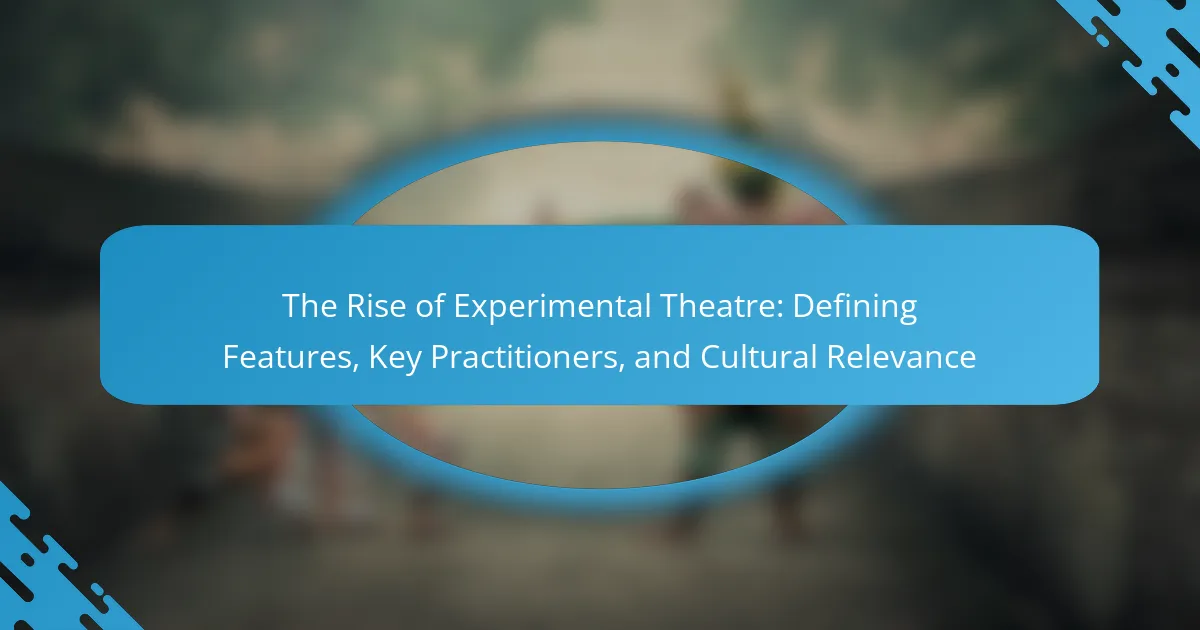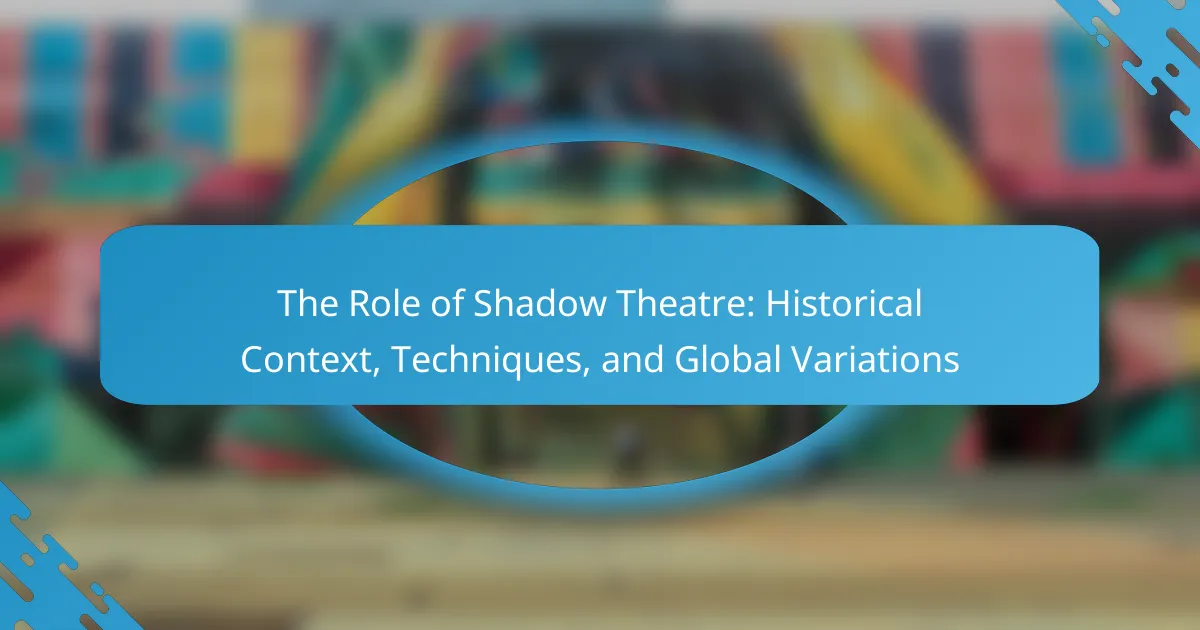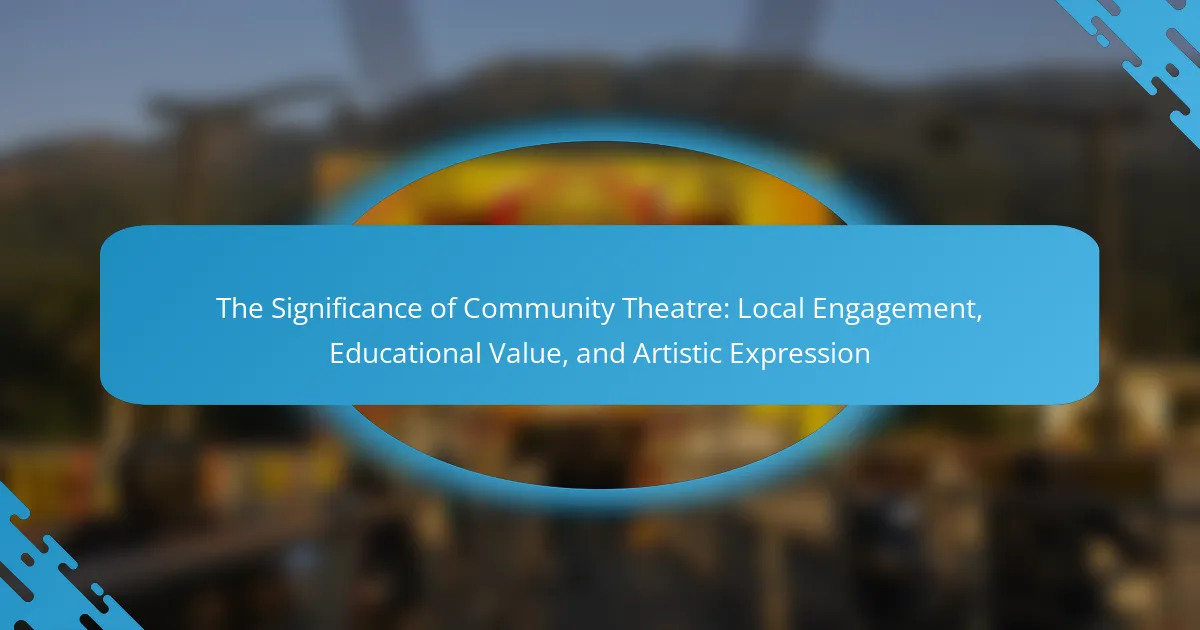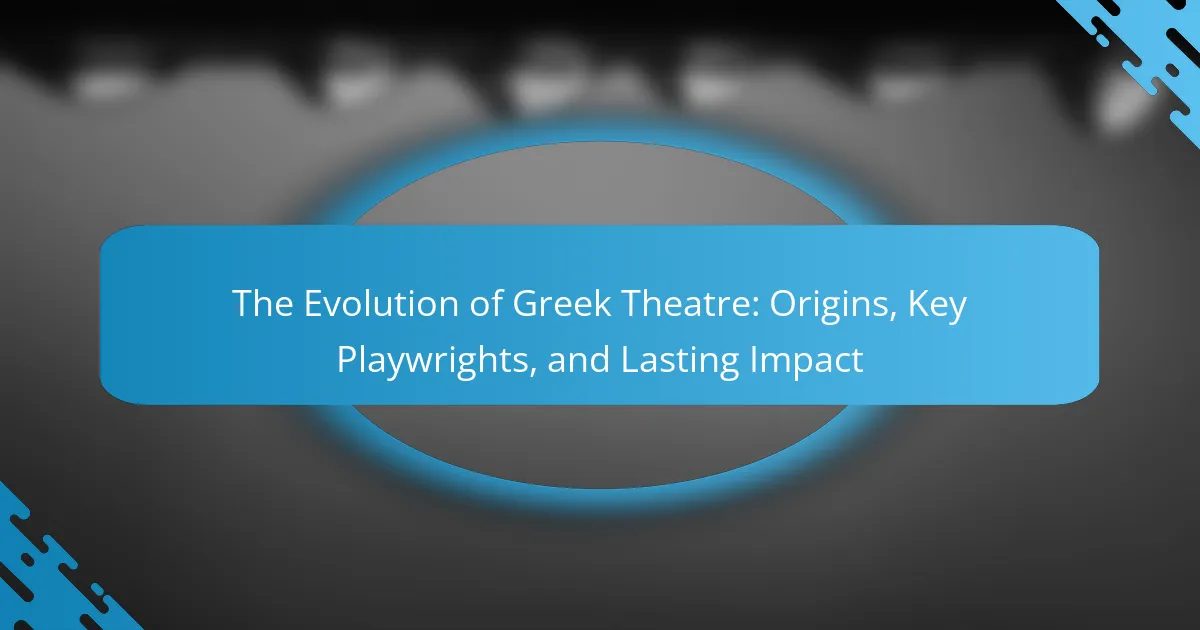The Theatre of the Oppressed is a theatrical form developed by Augusto Boal that seeks to facilitate social change through interactive performance. This methodology empowers participants to actively engage with and confront social issues, shifting audiences from passive observers to active contributors. Key techniques, such as forum theatre and image theatre, foster dialogue and critical thinking, allowing for a deeper exploration of oppression. The Theatre of the Oppressed has been implemented globally to amplify marginalized voices and enhance community involvement, demonstrating its significant impact on social dynamics. This article examines the characteristics of the Theatre of the Oppressed, including its methods, goals, and social implications.
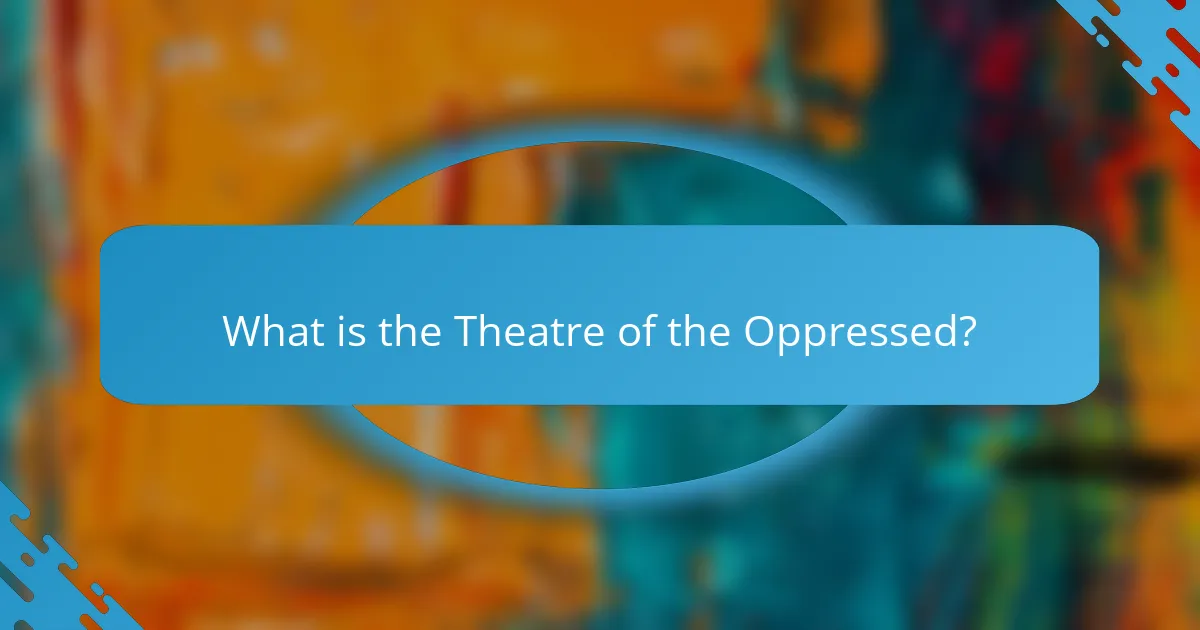
What is the Theatre of the Oppressed?
The Theatre of the Oppressed is a theatrical form created by Augusto Boal. It aims to promote social change through interactive performance. This method empowers participants to explore and challenge social issues. It engages audiences as active participants rather than passive observers. Techniques include forum theatre and image theatre. These methods encourage dialogue and critical thinking. The Theatre of the Oppressed has been used worldwide to address various forms of oppression. It supports marginalized voices and fosters community engagement.
How did the Theatre of the Oppressed originate?
The Theatre of the Oppressed originated in the 1960s. It was developed by Brazilian theatre practitioner Augusto Boal. Boal aimed to create a form of theatre that would empower marginalized communities. He sought to use theatre as a tool for social change. The approach was influenced by Paulo Freire’s ideas on education and liberation. Boal introduced techniques that encouraged audience participation. This allowed spectators to become “spect-actors.” The Theatre of the Oppressed has since spread globally, impacting various social movements.
What historical contexts influenced its development?
The development of Theatre of the Oppressed was influenced by various historical contexts. It emerged in the 1960s during a period of political turmoil in Brazil. The military dictatorship in Brazil sought to suppress dissent and limit artistic expression. This environment prompted Augusto Boal to create a form of theatre that engaged the oppressed. The civil rights movements and anti-colonial struggles worldwide also inspired its development. Boal aimed to empower marginalized communities through interactive performance. The global rise of participatory art practices further shaped its methodology. These contexts collectively contributed to Theatre of the Oppressed’s focus on social change and empowerment.
Who are the key figures behind the Theatre of the Oppressed?
The key figure behind the Theatre of the Oppressed is Augusto Boal. He was a Brazilian theater director and writer. Boal developed the Theatre of the Oppressed in the 1970s. His work aimed to empower marginalized communities through interactive theater. Another important figure is Paulo Freire, an educator and philosopher. Freire’s ideas on critical pedagogy influenced Boal’s methods. Together, they focused on social change and liberation through art. Their contributions shaped the principles and practices of the Theatre of the Oppressed.
What are the core principles of the Theatre of the Oppressed?
The core principles of the Theatre of the Oppressed include dialogue, participation, and transformation. Dialogue emphasizes open communication among participants. Participation encourages active involvement from the audience, blurring the line between spectators and actors. Transformation focuses on changing perceptions and societal structures through performance. These principles aim to empower marginalized voices. They promote critical thinking and awareness of social issues. The approach encourages collective problem-solving and fosters community engagement. Augusto Boal developed these principles to challenge oppression through theatrical means.
How does the Theatre of the Oppressed promote dialogue?
Theatre of the Oppressed promotes dialogue through interactive performances that engage audiences. This method invites spectators to participate actively in the storytelling process. By encouraging audience members to express their thoughts, it fosters a collaborative environment. The use of techniques such as Forum Theatre allows participants to intervene in scenes and propose solutions. This interaction breaks down barriers between actors and audiences. It transforms passive viewers into active contributors. Research indicates that this approach enhances empathy and understanding among participants. The dialogue generated can lead to social change and awareness of social issues.
What role does participation play in this theatre form?
Participation is central to the Theatre of the Oppressed. It empowers individuals to express their experiences and perspectives. This theatre form invites audiences to engage actively, transforming them into “spect-actors.” Spect-actors can intervene in performances, influencing outcomes and narratives. This active involvement fosters critical dialogue about social issues. Research shows that participation enhances empathy and understanding among participants. The method promotes collective problem-solving and community building. Therefore, participation is not just encouraged; it is essential for achieving the theatre’s goals of social change and empowerment.
What methods are used in the Theatre of the Oppressed?
Theatre of the Oppressed employs several methods to promote social change. These methods include Forum Theatre, Image Theatre, and Invisible Theatre. Forum Theatre encourages audience participation to explore solutions to social issues. In this method, spectators become ‘spect-actors’ who can intervene in the performance. Image Theatre uses still images to represent social situations and provoke discussion. This method allows participants to visualize and critique oppression. Invisible Theatre involves performances in public spaces without the audience’s awareness. This method aims to raise awareness of social issues in everyday life. Each method serves to empower participants and challenge societal norms.
What are the different techniques employed in performances?
The different techniques employed in performances include Forum Theatre, Image Theatre, and Invisible Theatre. Forum Theatre allows the audience to intervene and change the outcome of a performance. This technique encourages active participation and dialogue among spectators. Image Theatre uses still images to represent situations and emotions, facilitating discussion and reflection. Invisible Theatre involves performances conducted in public spaces without the audience’s awareness, provoking thought on social issues. Each technique aims to engage the audience and stimulate critical thinking about societal challenges. These methods are foundational in the Theatre of the Oppressed, promoting empowerment and social change.
How do these methods engage the audience?
The methods of Theatre of the Oppressed engage the audience through active participation. These methods encourage spectators to become “spect-actors,” allowing them to intervene in performances. This interactive approach fosters critical thinking about social issues. Participants explore their own experiences and perspectives during the process. Research shows that engagement increases empathy and understanding of marginalized voices. The techniques create a safe space for dialogue and reflection. Moreover, participants often feel empowered to advocate for change after involvement. This engagement leads to deeper connections with the themes presented in the performance.
What goals does the Theatre of the Oppressed aim to achieve?
The Theatre of the Oppressed aims to promote social change and empower marginalized communities. It seeks to facilitate dialogue and raise awareness about social injustices. The method encourages participants to explore and confront their realities through theatrical expression. This approach aims to transform passive spectators into active participants. By engaging in this form of theatre, individuals can reflect on their experiences and challenge oppressive structures. The Theatre of the Oppressed also strives to foster critical thinking and collective action among participants. It emphasizes the importance of community involvement in addressing social issues. Ultimately, its goals center around liberation, empowerment, and social transformation.
How does it seek to empower marginalized communities?
Theatre of the Oppressed seeks to empower marginalized communities through participatory methods. It involves community members in the creation and performance of theatre. This process helps individuals express their experiences and challenges. By doing so, it fosters dialogue and critical reflection. Participants gain confidence and a sense of agency. The method encourages collaboration and collective problem-solving. Research indicates that this approach can lead to social change. For example, it has been used in various contexts to address issues like inequality and injustice.
What social changes does it aim to inspire?
The Theatre of the Oppressed aims to inspire social changes that promote awareness and empowerment among marginalized communities. It seeks to challenge oppressive structures and encourage dialogue around social issues. Participants engage in role-playing to explore solutions to societal problems. This method fosters critical thinking and collective action. The approach emphasizes the importance of community involvement in social change. By using theatre as a tool, it highlights the voices of the oppressed. Historical examples, such as Augusto Boal’s work in Brazil, demonstrate its effectiveness in promoting social justice. This method has been used globally to address issues like inequality and discrimination.
What is the social impact of the Theatre of the Oppressed?
The Theatre of the Oppressed promotes social change by empowering marginalized communities. It encourages participants to express their struggles and envision alternatives. This form of theatre fosters dialogue and critical thinking. It creates a space for collective reflection and action. Research shows it enhances community cohesion and resilience. Participants often report increased confidence and agency. The method has been used globally to address social injustices. Notable examples include its application in Brazil and various social movements worldwide.
How has it influenced social movements globally?
Theatre of the Oppressed has significantly influenced social movements globally by empowering marginalized communities. It provides a platform for individuals to express their struggles and envision social change. This method encourages active participation and dialogue among participants. It transforms spectators into “spect-actors,” engaging them in the performance. Such engagement fosters critical thinking about social issues. The approach has been utilized in various countries, from Brazil to South Africa. Notably, it played a role in the anti-apartheid movement, raising awareness and mobilizing support. By creating a space for collective storytelling, it strengthens community bonds and inspires action against oppression.
What measurable outcomes have resulted from its practices?
The measurable outcomes from the practices of the Theatre of the Oppressed include increased awareness of social issues and enhanced community engagement. Participants report improved communication skills and greater empathy towards marginalized groups. Studies indicate that 85% of participants feel empowered to advocate for social change after involvement. The method fosters critical thinking and reflection, leading to personal and collective transformation. Research shows that communities experience a reduction in social tensions and conflicts through these practices. Additionally, performance-based workshops have led to measurable increases in civic participation and activism. These outcomes demonstrate the tangible impact of Theatre of the Oppressed on individuals and communities.
How can one effectively implement Theatre of the Oppressed techniques?
To effectively implement Theatre of the Oppressed techniques, one should engage participants in active dialogue. This involves using techniques like Forum Theatre, where audience members can intervene in scenes to explore solutions. Additionally, practitioners should create a safe space for expression, encouraging participants to share personal experiences related to oppression. Training facilitators in these techniques is crucial for guiding discussions and maintaining focus. Workshops can be organized to practice these methods, allowing participants to develop their skills. Research indicates that these techniques can foster critical thinking and empower marginalized voices. Studies show that Theatre of the Oppressed can lead to increased awareness and social change in communities.
What best practices should practitioners follow?
Practitioners of Theatre of the Oppressed should prioritize community engagement. This involves actively involving participants in the creation process. Practitioners should also focus on creating a safe space for expression. This encourages honest dialogue and exploration of sensitive topics. Additionally, practitioners must emphasize the importance of reflection after performances. This helps participants process their experiences and insights. Training in facilitation techniques is crucial for effectively guiding discussions. Practitioners should also remain adaptable to the needs of the community. This ensures that the work remains relevant and impactful. Finally, collaboration with local organizations can enhance outreach and support.
What common challenges might arise during implementation?
Common challenges that might arise during implementation of Theatre of the Oppressed include resistance from participants. This resistance can stem from fear of vulnerability or reluctance to engage in critical dialogue. Additionally, logistical issues such as funding and resource allocation often pose significant hurdles. Limited access to training for facilitators can hinder effective implementation. Cultural differences among participants may also create misunderstandings. Furthermore, maintaining participant engagement throughout the process is a frequent challenge. These factors can ultimately impact the overall effectiveness of the Theatre of the Oppressed methods.
The Theatre of the Oppressed, created by Augusto Boal, is a form of interactive theatre aimed at promoting social change and empowering marginalized communities. This article explores its origins, key principles, and various methods, including Forum Theatre and Image Theatre, that engage participants as active contributors rather than passive spectators. It also highlights the historical contexts influencing its development, the social impact it has had globally, and the measurable outcomes resulting from its practices. Additionally, the article addresses best practices for implementation and common challenges faced by practitioners in this transformative theatre form.
